
Calgranulin is an S100 calcium-binding protein that is expressed in multiple cell types, including renal epithelial cells and neutrophils.
The proteins S100A8 and S100A9 form a heterodimer called calprotectin.
Human genes
Function
Some in vitro evidence suggests that calgranulin can inhibit the precipitation of calcium oxalate in a urine-like environment at calgranulin concentrations below physiological concentrations. Thus, it may also function in vivo as an inhibitor of calcium oxalate kidney stone formation. However, the role of calgranulin in the stone formation process has not been evaluated.
See also
References
- Pillay S, Asplin J, Coe F (1 August 1998). "Evidence that calgranulin is produced by kidney cells and is an inhibitor of calcium oxalate crystallization". Am J Physiol. 275 (2 Pt 2): F255–61. doi:10.1152/ajprenal.1998.275.2.F255. PMID 9691016.
External links
- Calgranulin+A at the U.S. National Library of Medicine Medical Subject Headings (MeSH)
- Calgranulin+B at the U.S. National Library of Medicine Medical Subject Headings (MeSH)
| Cell signaling: calcium signaling and calcium metabolism | |||||||||||||||||
|---|---|---|---|---|---|---|---|---|---|---|---|---|---|---|---|---|---|
| Cell membrane |
| ||||||||||||||||
| Intracellular signaling |
| ||||||||||||||||
| Extracellular chelators |
| ||||||||||||||||
| Calcium-binding domains | |||||||||||||||||
| Protein: nerve tissue protein | |
|---|---|
| Synuclein | |
| Other | |
| Major histocompatibility complex classes | |
|---|---|
| MHC class I | |
| MHC class II | |
| Other | |